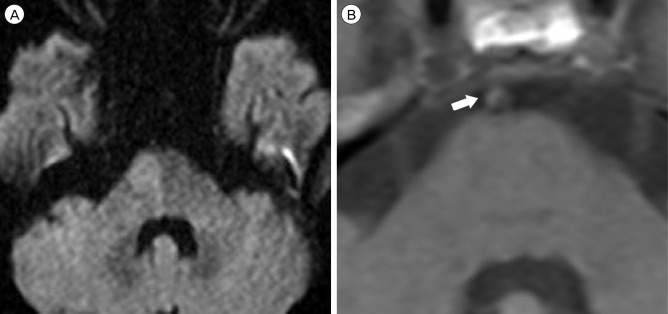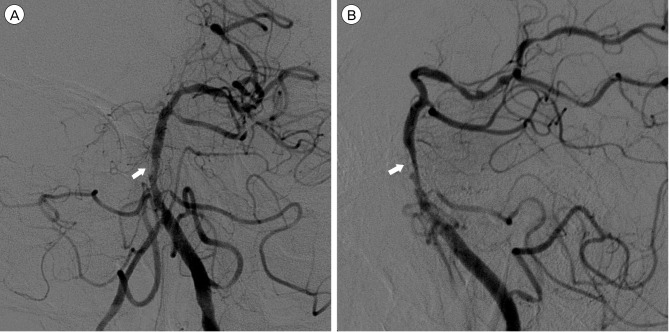J Cerebrovasc Endovasc Neurosurg.
2016 Jun;18(2):100-105. 10.7461/jcen.2016.18.2.100.
Acute Pontine Infarction due to Basilar Artery Dissection from Strenuous Physical Effort: One from Sexual Intercourse and Another from Defecation
- Affiliations
-
- 1Department of Neurosurgery, Daegu Fatima Hospital, Daegu, Korea. paulyoonsoolee@hanmail.net
- KMID: 2354883
- DOI: http://doi.org/10.7461/jcen.2016.18.2.100
Abstract
- A basilar artery dissection (BAD) is an extremely rare disease. It can lead to hemorrhage or infarction involving the brain stem, and is often associated with grave outcome. However, little is known about the pathophysiology of BAD, and its proper managements are yet in controversy. Herein, we report on two rare cases of basilar artery dissection from strenuous physical effort; one from sexual intercourse and another from defecation. The treatment modalities and the outcomes are also discussed.
Keyword
MeSH Terms
Figure
Reference
-
1. Berkovic SF, Spokes RL, Anderson RM, Bladin PF. Basilar artery dissection. J Neurol Neurosurg Psychiatry. 1983; 2. 46(2):126–129. PMID: 6842215.
Article2. Bogousslavsky J, Regli F. Ischemic stroke in adults younger than 30 years of age: cause and prognosis. Arch Neurol. 1987; 5. 44(5):479–482. PMID: 3579657.3. Delasobera BE, Osborn SR, Davis JE. a case of basilar artery dissection associated with sexual intercourse. J Emerg Med. 2012; 7. 43(1):e43–e47. PMID: 19818575.4. Endo S, Nishijima M, Nomura H, Takaku A, Okada E. A pathological study of intracranial posterior circulation dissecting aneuryms with subarachnoid hemorrhage: report of three autopsied cases and review of the literature. Neurosurgery. 1993; 10. 33(4):732–738. PMID: 8232816.5. Han Z, Leung TW, Lam W, Soo Y, Wong K. Spontaneous basilar artery dissection. Hong Kong Med J. 2007; 4. 13(2):144–146. PMID: 17406043.6. Higashida RT, Smith W, Gress D, Urwin R, Dowd CF, Balousek PA, et al. Intravascular stent and endovascular coil placement for a ruptured fusiform aneurysm of the basilar artery. J Neurosurg. 1997; 12. 87(6):944–949. PMID: 9384409.
Article7. Im TS, Lee YS, Suh SJ, Lee JH, Ryu KY, Kang DG. Two cases of subarachnoid hemorrhage from spontaneous aneterior cerebral artery dissection: a case of simultaneous hemorrhage and ischemia without aneurismal formation and another case of hemorrhage with aneurysmal formation. J Cerebrovasc Endovasc Neurosurg. 2014; 6. 16(2):119–124. PMID: 25045652.8. Inoue T, Fujimura M, Matsumoto Y, Kondo R, Inoue T, Shimizu H, et al. Simultaneous occurrence of subarachnoid hemorrhage and cerebral infarction caused by anterior hemorrhage and cerebral infarction caused by anterior cerebral artery dissection treated by endovascular trapping. Neurol Med Chir (Tokyo). 010; 7. 50(7):574–577. PMID: 20671384.9. Kim BM, Suh SH, Park SI, Shin YS, Chung EC, Lee MH, et al. Management and Clinical Outcome of Acute Basilar Artery Dissection. AJNR Am J Neuroradiol. 2008; 11. 29(10):1937–1941. PMID: 18687744.
Article10. Kim CH, Son YJ, Paek SH, Han MH, Kim JE, Chung YS, et al. Clinical analysis of vertebrobasilar dissection. Acta Neurochir (Wien). 006; 4. 148(4):395–404. PMID: 16511630.
Article11. Kitanaka C, Tanaka J-I, Kuwahara M, Teraoka A. Magnetic resonance imaging study of intracranial vertebrobasilar artery dissections. Stroke. 1994; 3. 25(3):571–575. PMID: 8128509.
Article12. Lee MS, Lee YS, Lee JH, Ryu KY, Kang DG. A case of actue basilar artery dissection associated with sexual intercourse: a life-trheatening cause of coital cephalgia. J Korean Soc Intravasc Neurosurg. 2011; 6. 6(1):42–46.13. Malek AM, Halbach VV, Phatouros CC, Meyers PM, Dowd CF, Higashida RT. Endovascular treatment of a ruptured intracranial dissecting vertebral aneurysm in a kickboxer. J Trauma. 2000; 1. 48(1):143–145. PMID: 10647582.
Article14. Manz HJ, Vester J, Lavenstein B. Dissecting aneurysm of cerebral arteries in childhood and adolescence. case report and literature review of 20 cases. Virchows Arch A Pathol Anat Histol. 1979; 10. 384(3):325–335. PMID: 160123.15. Nakahara T, Satoh H, Mizoue T, Kawamoto H, Kohmo Y, Kurisu K. Dissecting aneurysm of basilar artery presenting with recurrent subarachnoid hemorrhage. Neurosurg Rev. 1999; 10. 22(2-3):155–158. PMID: 10547021.
Article16. Nakatomi H, Nagata K, Kawamoto S, Furusho JI. Basilar artery occlusion due to spontaneous basilar artery dissection in a child. Acta Neurochir (Wien). 999; 1. 141(1):99–104. PMID: 10071693.
Article17. Pozaati E, Andreoli A, Padovani R, Nuzzo G. Dissecting aneurysms of the basilar artery. Neurosurgery. 1995; 2. 36(2):254–258. PMID: 7731504.
Article18. Shin YS, Kim HS, Kim SY. Stenting for vertebrobasilar dissection: a possible treatment option for nonhemorrhagic vertebrobasilar dissection. Neuroradiology. 2006; 2. 49(2):149–156. PMID: 17131115.
Article19. Suzuki K, Mishina M, Okubo S, Abe A, Suda S, Ueda M, et al. Anterior cerebral artery dissection presenting subarachnoid hemorrhage and cerebral infarction. J Nippon Med Sch. 2012; 4. 79(2):153–158. PMID: 22687360.
Article20. Willing SJ, Skidmore F, Donaldson J, Nobo UL, Chernukha K. Treatment of acute intracranial vertebrobasilar dissection with angioplasty and stent placement: report of two cases. AJNR Am J Neuroradiol. 2003; 5. 24(5):985–989. PMID: 12748108.21. Yamaura A, Ono J, Hirai S. Clinical picture of intracranial non-traumatic dissecting aneurysm. Neuropathology. 2000; 3. 20(1):85–90. PMID: 10935444.
Article22. Yasukawa K, Kamijo Y, Momose G, Kobayashi S, Ikeda A. A case of anterior cerebral artery dissecting aneurysm presenting subarachnoid hemorrhage and cerebral infarction at the same time. Surg Cereb Stroke. 1993; 10. 21(6):461–466.
Article
- Full Text Links
- Actions
-
Cited
- CITED
-
- Close
- Share
- Similar articles
-
- Traumatic Basilar Artery Dissection With Acute Pontine Infarction
- Extreme Duplication-type, Nonseparated Fenestration of the Basilar Artery in a Patient with Pontine Infarction: Confirmation with Virtual Arterial Endoscopy
- Clinical Significance of T2 Sagittal Image and the Flow Void of Basilar Artery in Pontine Infarction
- Automatic Stepping in Patients with Progressive Basilar Artery Infarction
- Microsurgical Anatomy of the Basilar Artery: Surgical Approaches to the Basilar Trunk and Vertebrobasilar Junction Aneurysms






